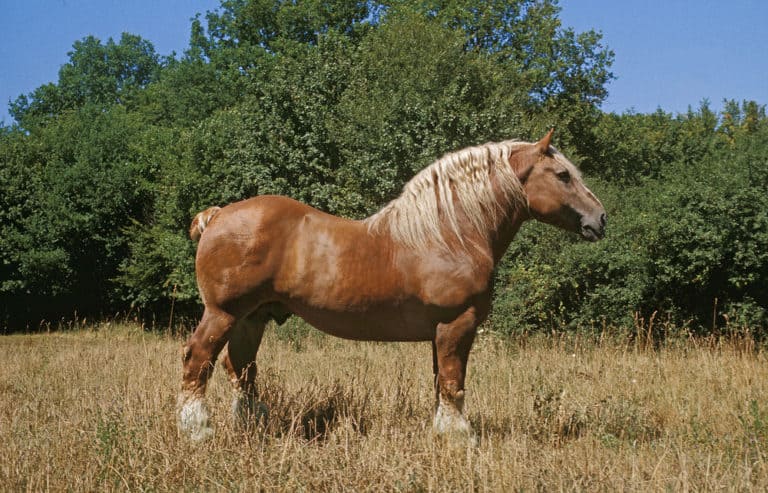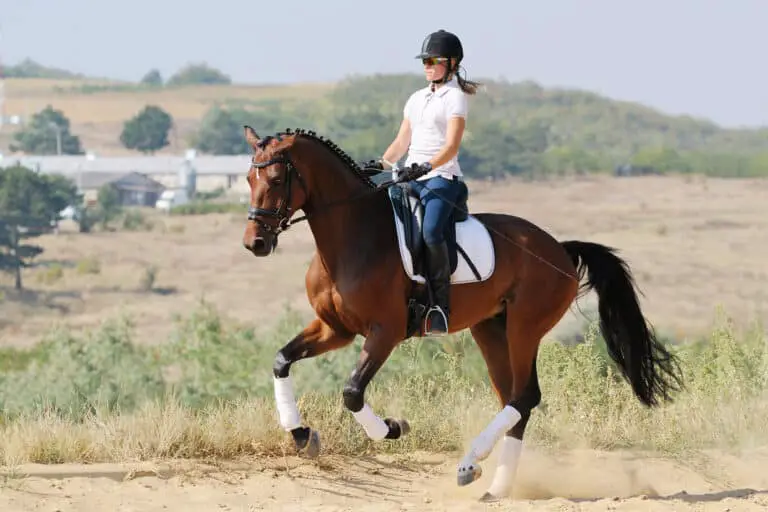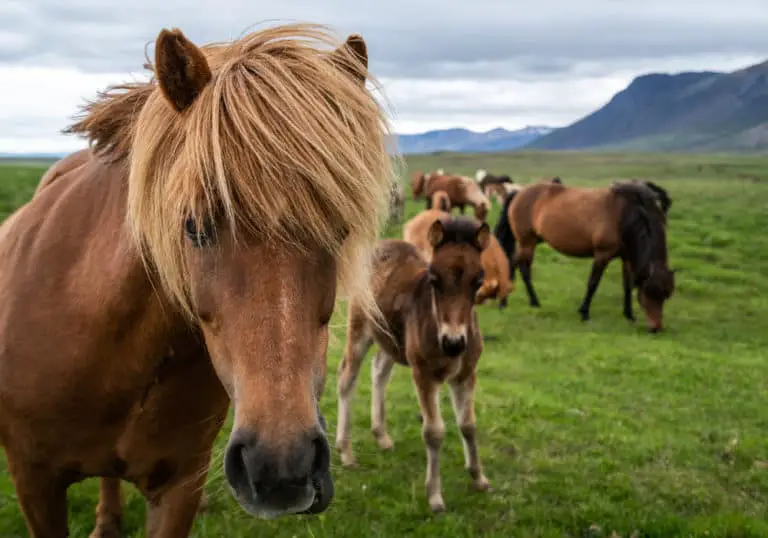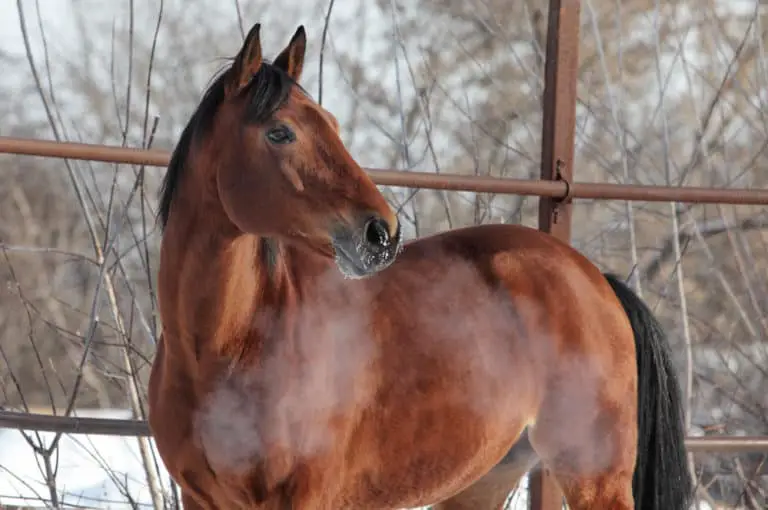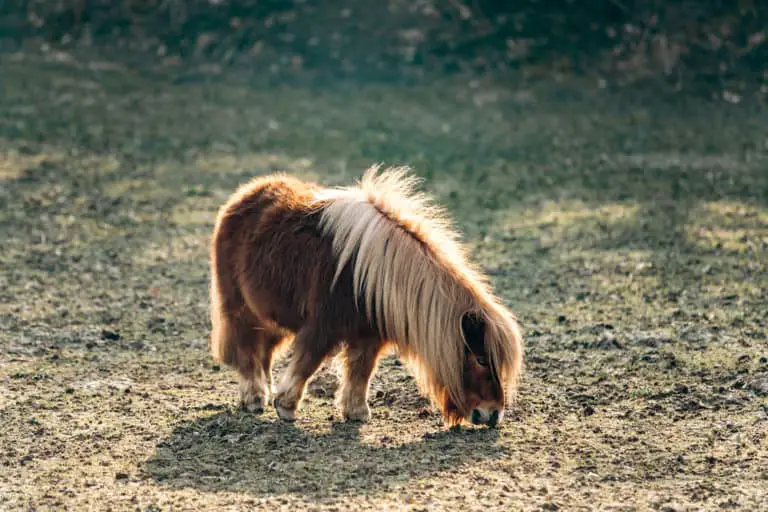Friesian Horse Breed: Care, Cost & History (2025)

The Friesian Horse is also called the Black Pearl. The breed comes from the small region of Friesland in the Netherlands.
Those beautiful black horses are the epitome of an elegant horse from medieval times. Their sparkly black coat, their wavy and shiny mane, and their feathers on the lower legs are not easy to forget.
Breed: Friesian horse
Adult Weight: 1,200-1,400 pounds
Adult Height: 15.1 to 17.3 hands (61-71 inches)
Origin: Friesland, The Netherlands
Use: Carriage, Trail Riding, Leisure, Dressage, Farming
Colors: Black (Bay, if bleached out from sunlight exposure)
Features: Large size, Feathers, wavy mane, heavy tail, Spanish-Head
Lifespan: Around 16 years (up to 25 years for certain individuals)
Character: Calm, gentle, friendly, durable
Gait: High-Knee Action
Best for: All levels of riders
- Characteristics
- Friesian Care
- Friesian History
- Modern Friesian
- Cost and Ownership
- Buying a Friesian
- Similar Breeds
Friesian Horse Characteristics
Friesian horse characteristics are distinctive and easy to notice. That is why it is relatively easy for even a horse novice to identify a horse of this breed. The Friesian has a sturdy and draught-type body that is covered in a silky black coat.
The Friesian horse head is called a “Spanish-type” head, meaning it is long and narrow. It is surrounded by a long and wavy, thick mane. They have feathery hair on their lower legs, called feathers, which is another typical characteristic for this breed.
Size
The average Friesian horse size stands at 15.3 hands which are 160 cm or 63 inches (1). Friesian horse height can be considered to be of medium to large size in comparison to other horse breeds.
The sizes between mares and Friesian stallions do not differ concerning the sex, but if you want your Friesian to qualify for a star-designation pedigree, your Friesian’s size needs to be at least 15.2 hands (62 inches or 157 cm) (1).
The breed’s size, in general, can differ from 15.1 to 17.3 hands. Even though they are draught-type horses, the Friesian height and elegant build enable them to compete in dressage nowadays.
In ancient times their size made them perfect for being used by knights since they were able to carry the heavy armor of a knight (1).
Weight
The Friesian horse weight lies between 1,200-1,400 pounds (1). They are sturdy and muscular horses which makes their bodies heavy and strong.
The black Friesian horse is considerably heavier than other breeds of similar height. They profit from a strong bone structure since they have been used for farming and carriage towing for almost their entire breeding history (2).
The weight of the Friesian does not hinder them from participating in more delicate disciplines like dressage or showjumping since they have an elegant walk and appearance regardless of their weight and build.
Colors
The beautiful Friesian horse is popular for its silky black coat. This is because the only accepted Friesian color in the studbook is black (3). Therefore the Friesian horse colors are not as miscellaneous as in other horse breeds.
Some Friezian horse breeds carry the “red” gene which will make their coat chestnut and there are rare Friesian horse colors like white and grey, but those are not acknowledged for purebreds (3).
Markings are not typical or desired within this breed. Only a small white star or marking on the forehead will be accepted (3).
If you are willing to go for a crossbreed Friesian, you will have a limitless amount of colors to choose from. You will not find a purebred grey Friesian horse, except it is significantly crossbred.
Temperament
The Friesian horse temperament is one of their best features. It discusses whether the Friesan is a warmblood or cold blood. They originate from coldblooded but have been crossbred with warmbloods.
Friesian horses are calm, gentle, and friendly horses (3). The gentle giants are known to be one of the most human-oriented breeds since they are so loving and affectionate with their riders, visitors, and especially children.
Despite their even temperament, they are still eager when it comes to working out or riding. There is nothing your Friesian will not be suitable for.
The Friesian horse behavior is ideal for any level of rider and there is nothing bad to say about the temperament of this breed. The United States Equestrian Federation regularly exhibits stallions of this breed (2).
Friesian Horse Care
When it comes to caring for a Friesian we are talking about a lot of time and upkeep involved. They can be considered high-maintenance when it comes to grooming and their health care.
The Friesian horse lifespan is a little bit shorter than that of other horse breeds with an average of 16 years.
Diet and Nutrition
The Friesian diet is the one aspect in the care of a Friesian that is not high-maintenance since they are natural grazers and do not need any particular food or supplement.
They should be healthy and happy if you provide them with high-quality hay, diverse pasture to graze through and a salt block to lick on once in a while to offer them enough minerals (4).
If your Friesian needs an energy boost, you can add some grain mixtures to their diet.
Regarding the amount of food, you can calculate with 18 pounds of hay per 1000 pounds of your horse’s body weight (4).
Health Problems
Friesians are a bit prone to health problems that you should know about. Since they prefer to be kept in colder climates, some Friesian Horses can suffer from anhydrosis, which is the lack of sweating (6).
If the environment is too hot, this can lead to serious issues like infections and circulation problems. Genetic problems like dwarfism and hydrocephalous can also be a problem within the breed (6).
Strong selective siring led to a decrease in bloodlines which resulted in inbreeding (6). This is one of the reasons for the rather short lifespan of the Friesian horse breed (6).
Pastern dermatitis is another illness that you need to look out for as horses with feathers are at risk to get infected if the feathers are not groomed daily (6).
Grooming
Friesian grooming is no joke. It is not easy at all to groom a Friesian horse (5). Despite the keep up of their beautiful outer appearance, you need to groom your Friesian every single day to keep them healthy.
This is because they have a heavy mane, tail, and feathers on their lower legs which need to be brushed every day to prevent dirt from settling down on the skin.
You need to brush the coat and detangle the tail, main, and feathers daily as well (5). The skin of Friesians can be dry and prone to skin irritation.
Hygiene and well-maintained coat and hair care are therefore essential (5). Wash the feathers of your Friesian every 2-3 days with a mild soap.
Friesian Horse History
Dating back to the 16th and 17th centuries the Friesian horse history is rich and colorful since the ancient Friesian horse was very popular among the medieval armored knights as a warhorse.
At certain points in history, they almost went extinct, but the tradition-loving people of the Netherlands saved the Friesians and made them as popular as they are today.
Origin
In the northwest of Europe is the small province of Friesland which is located in the Netherlands. Friesland is composed of a moderate maritime climate, flat green fields, and beautiful coastlines.
Those are the Friesian horse’s origin. The ancient riders of these horses were tradesmen, farmers, and seafarers. There is even earlier documentation from 1251 where historians believe the first Friesians to be mentioned (2).
The best-known part of the Friesians’ history is probably their use as warhorses in medieval times.
Since they were strong and sturdy, they were able to carry the heavy armor of the knights. The royal European courts appreciated the great performance of Friesians in a carriage which also made them popular carriage horses for European aristocrats.
Historic Development
At one point Arabian and Andalusian blood were introduced into the bloodline which gave the Friesians their beautiful “Spanish head” and their high knee-action.
At two points in history, the Friesian horse almost went extinct.
The first time was when the Dutch imported the Friesian to North America to help control the area of New York (2). Crossbreeding over there made the pure breed disappear from the US.
Later in the 19th century, the demand for multiple-use horses decreased and crossbreeding was introduced again since the people were looking for faster, slimmer, and lighter horses.
In the 20th century, it got so bad that there were only 3 purebred Friesians left in the Netherlands. The Het Friesch Paard society was founded to save the true Friesians and they have succeeded.
Notable Friesian Horses
There are quite a few famous Friesian horses that became popular through movies, books, their beautiful appearance, or even through dressage.
There are many horses from a Friesian horse pedigree who simply came to fame due to their amazing looks. The most notable Friesian horses that are still known today are Othello, Frederik the Great, and Raven.
Othello
Othello is the on-stage name of the beautiful Friesian stallion Goliath, who played in the movie “Ladyhawke” next to Michelle Pfeiffer, Matthew Broderick, and Rutger Hauer. Goliath was owned by Fred De Boer who was very grateful to the actors for making the breed world-famous.
Frederik the Great
Frederik was imported to the US from the Netherlands when he was six years old. He was a Friesian stallion who became famous since he looked stunning. He was titled to be the world’s best-looking horse. He even appeared on The Late Show with Stephen Colbert.
Raven
Raven is the main star of the 2017 released Netflix series “Free Rein”. He is a stunning jet-black Friesian cross. The series deals with his special connection to a young girl from the States who moved to the UK and learns to ride on Raven, even though he has a wild spirit.
Myths and Legends
Even though many think the Friesian to be a mystical horse and one would think many legends are surrounding these beautiful horses, there are not many documented legends or myths that tell us about Friesian legends or myths.
Friesian horse legends may be rare since they have been mainly used for farming and carriage pulling.
The Legend of Zorro
Tornado is the horse of Zorro and is said to be as jet-black as Zorros cape.
There are many different characteristics and appearances the fictional horse Tornado got assigned through numerous adaptions of movies and comics, but in the popular movie with Antonia Banderas, Tornado was played by a Friesian named Ariaan.
The Knights Warhorse
The most ancient legends and myths regarding Friesian horses are those of medieval times. Since Friesians have been used by knights for going into war or for lance fights.
The sturdy and strong body of the Friesian was ideal for carrying heavy armor. There are quite a few portraits and illustrations of horses that looked like Friesians from medieval times.
Princess Beatrix
For the 135th anniversary celebration of “The Friesian Horse Studbook,” Princess Beatrix of the Netherlands celebrated the history of the royal Friesian Horse in Leeuwarden. The royal society is dedicated to preserving the Friesian Horses History.
Modern Friesian Horses
The different types of Friesian horses are celebrated more than ever these days.
Not only purebreds but also the possibly healthier crossbreds are celebrated all over the world for their beautiful manes, feathers, and tails.
Friesian Horses are very popular as carriage horses for weddings all over the world since they look like they just sprung from a fairytale.
Breeding
Friesian breeding takes place in almost every country in the world except for very hot countries like Australia or Africa. But you may still be able to find Friesian Horses in warmer climates since they are a very popular horse breed all over the world.
Since the Friesians prefer a colder climate, the most significant breeding still takes place in the Netherlands, Germany, the UK, the US, and even Russia.
Friesian horses breeding is in high demand especially for smallholdings who can make good versatile use of the talented horse.
With their draught-type body, they are still being used as carriage horses. You will oftentimes see them in Old Towns pulling tourists in carriages.
Population
The Friesian horse population is numbered at 25,000 horses in the whole world. This is the number of registered Friesian horses in the Dutch Friesch Paarden Stamboek. (9)
Most of them are living in the Netherlands, their home country, where they are still being bred extensively. About 7% of the horses in the Netherlands are Frizians (10).
Approximately 8000 Friesians are registered in the US. To give you a comparison: there are more than 70,000 mustangs in the US (11).
Even though they are a pretty popular breed these days, the Friesian horse can be considered quite a rare breed, especially in North America.
Uses
Friesian horse uses are very versatile. They are ridden in harness and under saddle for many different disciplines, both for pleasure and in competition.
The Friesian horse gait is popular for the high-knee walk which is one of the reasons why they are used for dressage and in competition.
Due to their heavy build, they are still a beloved breed to harness in front of a carriage.
Since Friesians have not been bred to jump and their body build is not the most suitable for jumping, some riders still jump with their Friesians. They are often used for trail riding as well.
Friesian Horse Prices
As with all horses, the price of your Friesian Horse can vary a lot depending on where you live, what traits you are looking for in your horse as well as the achievements and heritage of the horse.
We will inform you about the different price ranges and the traits that define the price of a Friesian.
Purchase Price
The Friesian horse price will depend mainly on its traits. Those traits are age, sex, the training it has received, its health, and the bloodline or pedigree.
The price of a Friesian horse can be considered to be in the medium to high price range since there are not a lot of Friesians in the US.
You can pay as little as $500 (7) for an undocumented and untrained foal or up to $750,000 for a renowned priced stallion (7).
You would have to spend less for a Friesian in the Netherlands compared to the same value horse in the US. An average Friesian horse will cost you between $6,000-$9,000 (7).
Ownership Costs
The Friesian horse cost of ownership is a regular financial burden that horsemanship asks of us riders.
The Friesian price itself is just one investment of many when it comes to owning a Friesian. You will have to pay for board, feed, veterinarian care, and hoof care to keep your horse happy and healthy.
Board
The Friesian horse board cost will be around $250-$800 monthly (4). There are options of paying for full board or just pasture boarding.
The full board usually includes regular vet care, feed, hoof care, and exercising your horse.
The monthly full boarding cost will therefore be higher than compared to that of pasture boarding. Pasture boarding can cost as little as $200 per month (4).
Feed
When it comes to Friesian horse feed cost you will have to pay for high-quality hay and ensure that your horse can graze through the pasture. A bay of hale will cost you around $2-$4. Horses need about 15-30 bales per month.
If you are competing with your horse and it needs more energy you may have to add some grain feed which is around $13 for a 20kg bag that lasts about 1-2 weeks.
Vet Care
The annual Friesian horse veterinary cost will be approximately around $200-$300 if nothing serious occurs. These costs will cover the annual vaccinations, the deworming for 12 months, and teeth floating once or twice per year.
These costs do not cover anything unexpected like injuries, inflammations, or colics – all of them alone can easily cost you $500-$1,200 depending on the severity of the health problem.
Keep in mind that you may be confronted with skin issues with your Friesian since they can have dry skin.
Hoof Care
The Friesian horse hoof care cost is regular since you need to shoe your Friesian or trim their hooves regularly. Even if you let your Friesian walk barefoot, it needs to get a trim every 6-8 weeks.
Trimming your horses’ hooves will cost around $20-$35 for each trim. Shoeing your horse will cost you more than twice as much – around $80.
This brings the costs to anything from $150 to over $1,000 annually depending on your Friesians hoof care.
Buying a Friesian Horse
When it comes to buying a Friesian horse you will need to make your homework. Are you familiar with the costs, can you afford them, and potentially more unexpected costs in case your Friesian gets sick?
Has the Friesian breed the temperament you are looking for in your horse and does it meet your athletic expectations when it comes to exercising and riding?
In either case, you should meet and ride the horse before buying it.
Is the Friesian Horse Right for You?
Owning a Friesian comes with many responsibilities. There are numerous advantages and even some disadvantages. The bright side is that the Friesian breed is a good horse for all-level riders.
Due to their calm and friendly temperament, they are even suitable for beginners since they are forgiving of mistakes. Their versatile use makes them a good fit for many riders.
Riding a Friesian horse can be done for purposes of leisure or in competition.
If you are looking for a showjumping horse, you should move on from this breed since they are not built for jumping and there are better-suited breeds for you out there.
How to Buy a Friesian Horse?
If you are buying a Friesian horse you will first need to look for a renowned and well recommended Friesian breeder.
Visit the breeder and their horse farm to get an idea of how the Frisians are brought up.
Look out for cleanliness in the stables, how many horses there are (too many is never a good sign) and how the horses react to the breeder (loving and trusted relationship or distanced and even frightened?).
You should interact and ride the Friesian of your interest and talk with the breeder about the traits of the horse to see if it is a good fit for you.
If it feels like a quick sell on the seller’s side, move on. You are buying a living being and not a wandering object.
Similar Breeds to Friesian
The Frisian horse is not the only horse breed with voluminous manes and medieval elegance.
If you are a sport jumper, more interested in high-performance horses for dressage, or looking for an even bigger horse, then you should look out for Friesian breed alternatives like the Andalusian Horse, the Gypsy Horse, or Shire Horses.
Andalusian Horse
The Andalusian Horse is related to the Friesians since they were crossbred to redefine the Friesian horse. They have similar long manes, classic lines, and the same high-stepping gait. Since the Andalusians are more compact, they tend to be a little stronger than the Frisians.
Gypsy Horse
The Gypsy Cob Horse originates from Ireland and the UK. They have beautiful feathered lower legs and a heavy mane as well. The main difference between Gypsy Horses and Friesians is their coat colors since the Gypsy has a spotted, multicolor coat. Gypsies have a similar gentle character like Friesians.
Shire Horse
The Shire Horse is the biggest horse breed known to mankind. They are draught horses, have feathers like the Friesan, and a similar calm temperament. They can pull incredibly heavy amounts of weight and are gentle giants.
They are suitable for all levels of riders and are friendly horses. They can jump and participate in dressage, but like the Friesian, this would not be an obvious choice of breed for those disciplines.
FAQ
What is a Friesian horse?
The Friesian horse is a draught-type horse breed that originates from the region of Friesland in the Netherlands. They are called black pearls and are gentle and calm horses.
What does a Friesian horse look like?
Friesian Horses are popular for their silky-black coated bodies and their beautiful wavy manes and tails. Their manes are heavy and they have feathers on their lower legs.
How did the Friesian horse get its name?
The name of the Friesian horse derives from their place of origin, which is Friesland in the Netherlands. The beautiful black horses are the whole pride of the locals in Friesland.
Can you ride a Friesian horse?
Yes, you can ride a Friesian horse with no problems. They are versatile horses and can be used for many disciplines like leisure, competition, or trekking.
Are Friesian horses good for beginners?
Even if you are a beginner and not advanced in the art and sport of riding, the calm and friendly temperament of the Friesan will carry you safely.
How tall is a Friesian horse?
Friesian Horses are fairly tall and can be counted as one of the tallest breeds of horses. They usually stand at 15.1 to 17.3 hands (61-71 inches) (1).
How much does a Friesian horse weigh?
Friesians are heavy and strong horses with a lot of muscles. This makes them quite heavy with 1,200-1,400 pounds on average.
How big is a Friesian horse?
Even though Friesians are tall and heavy horses and have a draught-type body, they can elegantly perform their gaits and are not as big as draught breeds.
How much does a Friesian horse cost?
An average Friesian Horse will cost you around $4000-$8000. The traits of the horse, its bloodline and its age will mainly determine the price. Untrained and crossbred Friesian foals can cost as little as $500.
How much does Friesian horse ownership cost?
The cost of owning a Friesian Horse is not that different from owning a horse in general and can be anything from $350-$800 a month depending on your costs for board and vet care. The costs also depend on the region or city you live in. City regions are usually more expensive.
How long do Friesian horses live?
The Friesian’s lifespan is usually a little shorter than that of other breeds with an average of 16 years. Individuals are known to have lived up to 30 years, but the inbreeding and its resulting health problems have shortened this breed’s lifespan.
How fast can a Friesian horse run?
The Friesian Horse speed is not the fastest nor the slowest. They have an average speed of 25 to 30 mph (40 – 48.5 km/h). One of the slowest horse breeds can run only 10 mph and faster breeds can run up to 55 mph.
How much can a Friesian horse pull?
Like the Shire horse, the Friesian horse can pull a lot of weight with its draught-type body. They can pull up to 400 pounds.
How much can a Friesian horse carry?
Friesian Horses can carry up to 20% of their body weight. This means that to safely carry a rider weighing 250 pounds, the Friesian needs to weigh about 1,360 pounds.
At what age is a Friesian horse full grown?
A Friesian horse is fully grown at five or six years of age. You can not ride a Friesian until it is older than two years. The Knee caps of horses close approximately between 18 to 24 months.
What are Friesian horses used for?
Friesians can be used for leisure, Western and English riding, in a carriage, or even for dressage.
References
- The Livestock Conservancy. 2022. Friesian Horse. Link
- The U.S. Equestrian Federation. 2022. Friesian. Link
- Friesian Horse Association of Great Britan. 2022. Link
- Iron Spring Farm, Ray Geor, BVSc, PhD, Dipl. ACVIM. 2022. Horse Nutrition: From Start to Finish. Link
- Horse Illustrated, Kim Klimek. 2021. Care of Long Manes and Tails. Link
- International Committee of Connemara Pony Societies (ICCPS). 2013. The Trouble with Friesians. Link
- KFPS Royal Friesian. 2022. Marketplace. Link
- KFPS Royal Friesian. 2022. Marketplace. Link
- FHANA Royal Friesian. 2022. How many Friesians are there? Link
- Animalfife. 2022. Friesian Horse. Link
- Alina Bradford, Patrick Pester, Live Science. 2021. Mustangs: Facts about America’s ‘wild’ horses. Link

